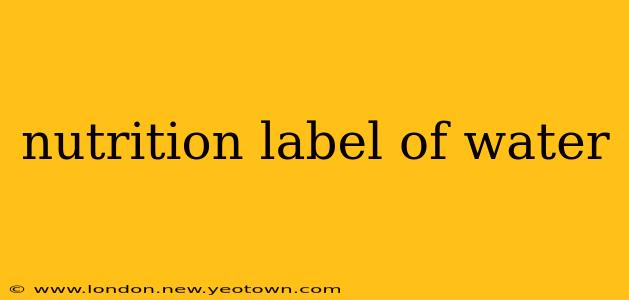Decoding the (Surprisingly Interesting) Nutrition Label of Water
Let's be honest, we rarely give a second glance to a bottle of water before chugging it down. But have you ever really looked at a water label? It might seem pointless – after all, it's just water, right? Wrong! Even the simplest things can hold surprising details, and understanding what's (or isn't) on a water label can tell you a lot about its source and purity. This journey into the world of water labels will reveal more than you might expect.
Imagine this: You're at the grocery store, faced with a wall of sparkling, still, purified, spring, and mineral waters. Each bottle boasts its own unique story, subtly hinted at on its label. Understanding those hints is key to making an informed choice.
What's Typically Found on a Water Label?
While the specifics vary depending on location and regulations, most water labels will include some or all of the following:
-
"Water": This seems obvious, but it's the foundation! It confirms the primary ingredient.
-
Source Information: This is where things get interesting. The label should indicate the water's source – is it sourced from a spring, well, or municipal supply? This often dictates the mineral content. "Spring water," for example, is collected directly from an underground spring, while "purified water" has undergone a treatment process to remove impurities.
-
Mineral Content (if applicable): "Mineral water" contains naturally occurring minerals exceeding a certain level. The label will usually list the amounts of key minerals like calcium, magnesium, sodium, and potassium. This varies widely depending on the source.
What About Calories, Fat, and Sugar?
Many people wonder about the absence of typical nutrition facts on water labels. The reason is simple: pure water contains almost no calories, fat, or sugar. These components are essentially absent, so they are omitted. Any exceptions usually indicate added flavors or sweeteners.
Is it Necessary to Check the Nutrition Label on Bottled Water?
Yes, while seemingly unnecessary at first glance, checking the label offers valuable information about the water's source and purity. Here is what to look for:
-
Source Identification: Understanding the origin provides insight into the water's potential mineral content and any potential contaminants. Spring water, for instance, often contains naturally occurring minerals, impacting taste and potential health benefits. Purified water, on the other hand, is processed to remove impurities, resulting in a neutral flavor.
-
Mineral Content (for mineral waters): Knowing the mineral profile can guide your selection based on personal preferences or dietary needs. Some minerals may be beneficial for hydration and overall health.
-
Added Ingredients: Be wary of any added ingredients beyond pure water. Artificial sweeteners, flavors, or other additives can affect the taste and potentially your health.
What's the Difference Between Spring Water, Purified Water, and Mineral Water?
This is a common question, and the label is your key to understanding the differences:
-
Spring Water: Collected from an underground source, often naturally filtered. It might contain minerals depending on the geological source.
-
Purified Water: Water that has undergone treatment to remove impurities, resulting in a pure, neutral taste. The specific treatment methods can vary.
-
Mineral Water: Water naturally enriched with minerals from its underground source. The mineral content is typically detailed on the label.
What are the potential health benefits or risks associated with different types of bottled water?
Generally, pure water is the best option for hydration. However, mineral water can provide additional electrolytes if you need them (particularly after a workout or in hot weather). Always check the sodium content in mineral water as excessive sodium intake isn't advisable for everyone. The potential risks are primarily associated with added ingredients or contaminants. Always choose reputable brands to minimize the risk of impurities.
In conclusion, although seemingly straightforward, the water label provides crucial information about the water's source, purity, and mineral content. Taking a moment to read it helps make informed decisions that best suit your needs and preferences. So next time you grab a bottle, remember – that simple label holds a surprising amount of information!

